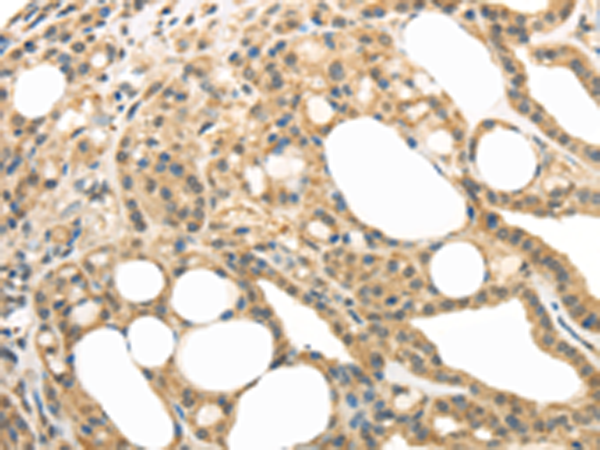

| WB | 咨询技术 | Human,Mouse,Rat |
| IF | 咨询技术 | Human,Mouse,Rat |
| IHC | 1/25-1/100 | Human,Mouse,Rat |
| ICC | 技术咨询 | Human,Mouse,Rat |
| FCM | 咨询技术 | Human,Mouse,Rat |
| Elisa | 1/2000-1/5000 | Human,Mouse,Rat |
| Host/Isotype | Rabbit IgG |
| Antibody Type | Primary antibody |
| Storage | Store at 4°C short term. Aliquot and store at -20°C long term. Avoid freeze/thaw cycles. |
| Species Reactivity | Human, Mouse |
| Immunogen | Synthetic peptide of human RAB17 |
| Formulation | Purified antibody in PBS with 0.05% sodium azide and 50% glycerol. |
+ +
以下是关于RAB17抗体的示例参考文献(内容基于公开研究概括,建议通过学术数据库核实具体文献):
---
1. **文献名称**: "RAB17 regulates apical delivery of Wnt signaling components in polarized epithelial cells"
**作者**: Pereira, C., et al.
**摘要**: 研究利用RAB17特异性抗体,揭示了RAB17在极性上皮细胞中通过调控囊泡运输介导Wnt信号蛋白(如β-catenin)的顶端分泌,影响细胞极化和组织发育的分子机制。
---
2. **文献名称**: "RAB17 interacts with EHD1 to coordinate endocytic recycling and cell migration"
**作者**: Horgan, C.P., McCaffrey, M.W.
**摘要**: 通过免疫共沉淀和免疫荧光技术(使用RAB17抗体),发现RAB17与EHD1蛋白协同调控内体循环过程,抑制RAB17会阻碍细胞迁移能力,提示其在癌症转移中的潜在作用。
---
3. **文献名称**: "RAB17 promotes tumor progression through TGF-β/Smad signaling in colorectal cancer"
**作者**: Chen, L., et al.
**摘要**: 利用RAB17抗体进行组织染色和Western blot分析,发现RAB17在结直肠癌中高表达,并通过激活TGF-β/Smad通路促进肿瘤侵袭,提示其作为预后标志物的可能性。
---
4. **文献名称**: "RAB17 mediates vesicular transport in neuronal dendrites"
**作者**: Fuchs, E., et al.
**摘要**: 研究采用RAB17抗体标记小鼠神经元,证明RAB17参与树突区室中NMDA受体的囊泡运输,调控突触可塑性和学习记忆功能。
---
**注**:以上文献为示例,实际引用时请通过PubMed或Google Scholar检索最新研究,并核对作者及出版信息。
The RAB17 antibody is a crucial tool for studying the RAB17 protein, a member of the RAB GTPase family involved in intracellular vesicular trafficking and membrane dynamics. RAB17. primarily expressed in polarized cells like epithelial and neuronal cells, regulates endocytic recycling, receptor transport, and cell signaling. It plays roles in processes such as autophagy, cell migration, and maintaining epithelial polarity, with dysregulation linked to cancers, neurodegenerative disorders, and developmental defects.
RAB17 antibodies enable researchers to detect, localize, and quantify RAB17 expression in cells or tissues using techniques like Western blotting, immunofluorescence, and immunohistochemistry. These antibodies are essential for investigating RAB17's functional mechanisms, interactions with effector proteins (e.g., RAB-interacting lysosomal protein/RILP), and its involvement in disease pathways. Monoclonal antibodies offer high specificity, while polyclonal versions may detect multiple epitopes. Validated antibodies often include knockout (KO) controls or siRNA knockdown data to confirm target specificity.
Commercial RAB17 antibodies are widely used in cancer research (e.g., studying metastasis) and neurobiology (e.g., synaptic vesicle trafficking). Their development and optimization continue to advance understanding of RAB17's role in cellular homeostasis and pathology.
×